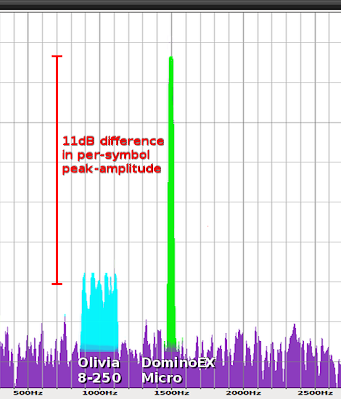Table of Contents
DominoEX Micro is a new soundcard based digital mode designed for the 2200 meter, 600 meter, 160 meter, and higher amateur radio bands.
This new mode is:
- As robust as Olivia ( perfect copy at -15 db SNR )
- As narrow as PSK31 ( 36 Hz bandwidth )
The major limiting factors on the LF and MF amateur radio bands are low radiated power and high noise. Antennas at these low frequencies suffer from very low efficiency and little of the power sent to them is converted into RF.
In order to overcome the low power output at these frequencies, DominoEX micro's speed is slowed down to 2 baud. This increases the watts/Hz (spectral density) of the transmitted signal, focusing the power into a very-narrow bandwidth.
On the receive side this sharp signal translates into an increased signal-to-noise ratio. Further gain can be achieved by using very-narrow receive filters.
This mode is also a great tool for low-power digital operation, or in place of QRSS.

Signal 36 Hz wide | 
Compared to Olivia 8/250 |
The modem code for DominoEX uses a wide band multiple frequency detector that can lock on and detect the incoming signal even when badly mistuned. Frequency domain oversampling is used to allow proper tone detection without the need for AFC. The AFC control does not alter the decoder in any way.
There is just one mode of DominoEX micro
| Name | Baudrate | Bitrate | Datarate | FEC |
|---|---|---|---|---|
| DominoEX Micro | 2 | 8 bits/sec | 8 bits/sec | None |
Performance
DominoEX Micro can achieve 100% decode at signal to noise ratios lower than -15 dB, which makes it more robust than Olivia. This mode can be decoded properly even when to the human ear, the incoming signal sounds like pure noise.
Such performance is achieved by using a very low baudrate, which increases the spectral density (watts-per-Hz) of the transmitted signal.
The signal to noise ratio (SNR) for any mode is calculated as a ratio of the Energy-per-bit / Noise-Level. For DominoEX Micro the energy-per-bit (at 25 watts) would be 25 watts X 0.5 seconds, or 12 watt/sec per symbol: 3 watt/sec per bit.
For Olivia 8-250, the lowest SNR Olivia mode: 25 watts X 0.032 seconds or 0.8 watt/sec per symbol: 0.26 watt/sec per bit. The effective DominoEX Micro signal strength is 11 times that of of the equivalent Olivia signal.
Having a very-low baudrate is how DominoEX Micro is comparable to Olivia, even without forward error correction. The modulation for this micro mode can be decoded when an equivalent Olivia modulation fails. No amount of Forward Error Correction can compensate for a complete loss of decode at the de-modulation step.
On the 2200, 630, and 160 meter bands this increase in effective received-signal power helps overcome the massive system losses and high-noise levels encountered when using these low frequencies.
Multi-language UTF-8 Support
DominoEX Micro supports sending all UTF-8 characters. This means the mode can be used to communicate in any language.
Please ensure the font chosen in Fldigi has the characters for the language you are trying to use, otherwise Fldigi will just display every character as an empty box.
IFK+ Modulation
DominoEX Micro uses a modulation scheme known as Incremental Frequency Keying Plus (IFK+). It is very similar to 18-tone MFSK modulation, but with many benefits.
Using IFK+ modulation is what allows DominoEX Micro to achieve it's very-narrow bandwidth. IFK+ modulation is much easier to tune than an MFSK signal of the same baudrate. For MFSK, a signal must be tuned to an accuracy of baudrate / 3. This results in an accuracy requirement of less than 1 Hz (at 2 baud).
The tuning accuracy requirement of IFK+ is bandwidth / 2. This is about 18Hz for a 2 baud IFK+ signal. This tuning can easily be achieved by manually clicking on the signal in the waterfall display, just like a PSK31 signal, or by presetting the receiver to within +/- 18 Hertz of the target frequency.
IFK+ is a differential-type MFSK modulation where the data-bits are encoded as the frequency difference between the previous tone and the next tone.
Number (bits) to be sent: 3 (0011)
Previous tone: 4 (0100)
Transmitted tone: 3 + 4 + 2 = 9 (1001)
Since there are only 18-tones in DominoEX micro, the number simply wraps around back to 0 when it reaches number 19.
The current tone always has 2 added before transmitting. This introduces a known pattern within the signal that benefits soft-decision decoding, and improves resistance to intersymbol interference.